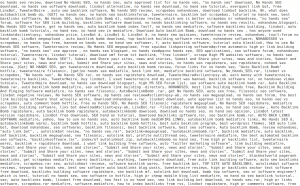A while back I wrote about how many SEO companies and so-called SEO experts have been offering a Google Penguin Recovery Service. I mentioned that you really need to be very careful when choosing someone who offers to help you recover from Penguin, because they really can do more harm than good. They are, in fact, going to do things that will change your website’s link profile which could do serious damage to your overall website search engine reputation. You actually gain search engine reputation over the years, and your domain name has a history.
Take a look at my presentation about the latest Google Algorithm Updates, paying particular attention to the section on Google Penguin:
Google Penguin is entirely about links to your site, right?!? Wrong! Below, I’ll detail why Google Penguin is not all about the links that are pointing to your website. In fact, if you read the original (official) blog post from Google that describes Google Penguin, they describe Google Penguin as an algorithm targeted at webpam. Google states specifically in the blog post announcing Google Penguin:
Here’s an example of a webspam tactic like keyword stuffing taken from a site that will be affected by this change (referring to Google Penguin):
Of course, most sites affected by this change aren’t so blatant. Here’s an example of a site with unusual linking patterns that is also affected by this change. Notice that if you try to read the text aloud you’ll discover that the outgoing links are completely unrelated to the actual content, and in fact the page text has been “spun” beyond recognition
Sites affected by this change might not be easily recognizable as spamming without deep analysis or expertise, but the common thread is that these sites are doing much more than white hat SEO; we believe they are engaging in webspam tactics to manipulate search engine rankings.
Reading the above, honestly it is (and was) the same old drivel that we get from Google about webspam tactics that are trying to manipulate search engine rankings. Links schemes are mentioned, but not as prominently as what it shown in the actual screen shots that I’ve posted above that Google referred to in the actual blog post.
There are a lot of SEO experts out there who are saying that they can do Google Penguin Recovery but when you start talking to them they start referring to low quality links and how all of those need to be disavowed using the Google Disavow Tool. Their focus is cleaning up the links to your website.
No doubt, cleaning up low quality links pointing to your website as well as cleaning up the anchor text of the links pointing to your website is important. And that absolutely needs to be done (well, at least your links need to be thoroughly reviewed). An SEO expert such as myself, with 10 plus years of looking at links and knowing the history of link schemes, should review the site’s link profile.
Rae did a wonderful job at explaining what’s going on with links related to Penguin, and the whole “algorithmic versus manual” link penalties. I get that, it’s an awesome post. But one thing that she totally forgot about was the fact that Google Penguin is not totally about incoming links from other websites pointing to the site that got hit by Google Penguin.
Again, I go back to the original blog post from Google that announced Google Penguin. Right there on the Google Webmaster Central blog. In the post, Matt Cutts does mention link schemes which are, I believe, a part of Google Penguin and recovery.
So what’s the bottom line here, really? Google Penguin not just about cleaning up anchor text, cleaning up the links pointing to your site, getting rid of low quality links from other websites. Those are link schemes, and need to be taken care of. But it’s about the bigger picture here, cleaning up everything that has been done to a website (even outgoing links could potentially be a problem), and just about anything else, like keyword stuffing, that is deemed to violate Google’s quality guidelines.

